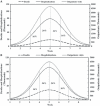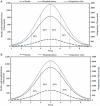Estimates of the impact of a future influenza pandemic in China
- PMID: 21462394
- PMCID: PMC4986579
- DOI: 10.1111/j.1750-2659.2009.00093.x
Estimates of the impact of a future influenza pandemic in China
Abstract
Background: The next influenza pandemic will create a surge in demand for health resources in China, with its current population of >1·3 billion persons and under-developed medical care and public health system. However, few pandemic impact data are available for China.
Objectives: We estimated the effects of a future influenza pandemic in China by examining pandemic scenarios of varying severity and described the time distribution of cases during a first wave.
Methods: We used a Monte-Carlo simulation model and death rates, hospitalizations and outpatient visits for 1918- and 1968- like pandemic scenarios and data from the literature or experts' opinion to estimate four health outcomes: deaths, hospitalizations, outpatient medical visits and clinical illness for which medical care was not sought. For each of the two scenarios we estimated outcomes by week using a normal distribution.
Results: We estimated that a 1968 scenario in China would result in 460,000-700,000 deaths, 1·94-2·27 million hospitalizations, 111-117 million outpatient visits and 192-197 million illnesses for which medical care was not sought. Fifty-two percent of hospitalizations occurred during the two-peak weeks of the first wave. We estimated that patients at high-risk of influenza complications (10-17% of the population) would account for 61-75% of all deaths. For a 1918 scenario, we estimated that 4·95-6·95 million deaths, 20·8-22·7 million hospitalizations and 101-108 million outpatient visits could occur.
Conclusion: Even a 1968 pandemic scenario will pose substantial challenges for the medical and public health system in China, and planning to manage these challenges is essential.
Figures
Similar articles
-
Modelling community-control strategies to protect hospital resources during an influenza pandemic in Ottawa, Canada.PLoS One. 2017 Jun 14;12(6):e0179315. doi: 10.1371/journal.pone.0179315. eCollection 2017. PLoS One. 2017. PMID: 28614365 Free PMC article.
-
Estimating the impact of the next influenza pandemic on population health and health sector capacity in New Zealand.N Z Med J. 2004 Mar 11;118(1211):U1346. N Z Med J. 2004. PMID: 15778744
-
The economic impact of pandemic influenza in the United States: priorities for intervention.Emerg Infect Dis. 1999 Sep-Oct;5(5):659-71. doi: 10.3201/eid0505.990507. Emerg Infect Dis. 1999. PMID: 10511522 Free PMC article. Review.
-
The burden and severity of illness due to 2009 pandemic influenza A (H1N1) in a large US city during the late summer and early fall of 2009.Am J Epidemiol. 2012 Sep 15;176(6):519-26. doi: 10.1093/aje/kws137. Epub 2012 Sep 5. Am J Epidemiol. 2012. PMID: 22952308
-
[A review on the preparedness plans on influenza pandemics, by WHO and China: the current status and development].Zhonghua Liu Xing Bing Xue Za Zhi. 2018 Aug 10;39(8):1032-1035. doi: 10.3760/cma.j.issn.0254-6450.2018.08.004. Zhonghua Liu Xing Bing Xue Za Zhi. 2018. PMID: 30180423 Review. Chinese.
Cited by
-
A review of the evidence to support influenza vaccine introduction in countries and areas of WHO's Western Pacific Region.PLoS One. 2013 Jul 16;8(7):e70003. doi: 10.1371/journal.pone.0070003. Print 2013. PLoS One. 2013. PMID: 23875015 Free PMC article. Review.
-
The 2009 influenza pandemic begins.Influenza Other Respir Viruses. 2009 Sep;3(5):197-8. doi: 10.1111/j.1750-2659.2009.00099.x. Influenza Other Respir Viruses. 2009. PMID: 19702580 Free PMC article. No abstract available.
References
-
- World Health Organization . Cumulative number of confirmed human cases of avian influenza A/(H5N1) reported to WHO. Available at http://www.who.int/csr/disease/avian_influenza/country/cases_table_2009_... (Accessed 25 April 2009).
-
- Horimoto T, Kawaoka Y. Influenza: lessons from past pandemics, warnings from current incidents. Nat Rev Microbiol 2005; 3:591–600. - PubMed
-
- Lanford C. Did the 1918–19 influenza pandemic originate in China? Popul dev rev 2005; 31:473–505.
-
- Patriarca PA, Cox NJ. Influenza pandemic preparedness plan for the United States. J Infect Dis 1997; 176(Suppl 1):S4–S7. - PubMed
-
- Webster RG. Predictions for future human influenza pandemics. J Infect Dis 1997; 176(Suppl 1):S14–S19. - PubMed
Publication types
MeSH terms
LinkOut - more resources
Full Text Sources
Medical



